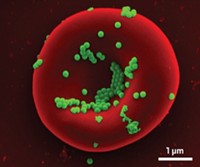Advertisement
Grab your lab coat. Let's get started
Welcome!
Welcome!
Create an account below to get 6 C&EN articles per month, receive newsletters and more - all free.
It seems this is your first time logging in online. Please enter the following information to continue.
As an ACS member you automatically get access to this site. All we need is few more details to create your reading experience.
Not you? Sign in with a different account.
Not you? Sign in with a different account.
ERROR 1
ERROR 1
ERROR 2
ERROR 2
ERROR 2
ERROR 2
ERROR 2
Password and Confirm password must match.
If you have an ACS member number, please enter it here so we can link this account to your membership. (optional)
ERROR 2
ACS values your privacy. By submitting your information, you are gaining access to C&EN and subscribing to our weekly newsletter. We use the information you provide to make your reading experience better, and we will never sell your data to third party members.
Pharmaceuticals
Nanoparticles to diagnose and treat atherosclerosis
Synthetic materials mimic ‘good cholesterol’ functionality in helping clean up dangerous plaques
by Stu Borman
March 21, 2016
| A version of this story appeared in
Volume 94, Issue 12
Researchers have developed nanoparticles that localize to arterial plaques and provide a possible new means to diagnose and treat atherosclerosis. Early detection of atherosclerosis is difficult and effective therapies are not available, making the condition a common cause of death worldwide. Plaques that are the hallmark of the disease form when white blood cells called macrophages attract cholesterol and agglomerate in arteries. These buildups can cause heart attacks, and when macrophages die, they can cause plaques to rupture and block blood flow, potentially causing strokes. High-density lipoprotein (HDL, or “good cholesterol”) deters plaque formation by promoting transport of cholesterol from plaques to the liver for excretion. In 2013, Shanta Dhar’s group at the University of Georgia reported the development of synthetic nanoparticles that mimic HDL functionally. In San Diego last week, Dhar and coworkers reported a modified version. The nanoparticles include a sugar-based macrophage-targeting ligand; an apolipoprotein-like peptide to bind cholesterol; and a magnetic agent that allows magnetic resonance imaging of plaques. After zeroing in on atherosclerotic lesions with their targeting ligands, the nanoparticles transport macrophages and cholesterol to the liver for disposal. Dhar hopes to begin clinical trials of the nanoparticles in a few years.




Join the conversation
Contact the reporter
Submit a Letter to the Editor for publication
Engage with us on Twitter